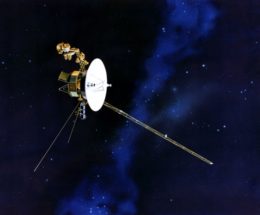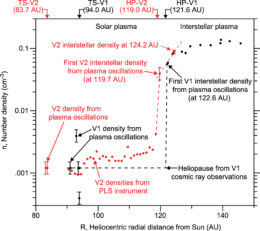In 1977, two space probes were launched from Earth, flung out toward the farthest reaches of our solar system. Now, 43 years later, Voyager 1 and Voyager 2 are journeying through interstellar space — and they’re still providing new insights.
Voyaging to the Outer Edge
The original mission of the Voyager spacecraft was to study the giant planets in our outer solar system. But across 43 years and three mission extensions, these little probes have gone on to do so much more — most recently crossing out of the heliosphere and providing our first up-close look at interstellar space.

Artist’s conception of the heliosphere (shown in the opposite orientation as in the cover image above). The heliospheric nose is on the left here, and the tail is on the right. Click to enlarge. [NASA/Goddard/Walt Feimer]
Into the Unknown
When Voyagers 1 and 2 were launched, they were sent in slightly different directions — so they’re now exploring two different regions of the interface between the heliosphere and the interstellar medium. In 2012, Voyager 1 crossed the boundary of the heliosphere on one side of the nose, at a distance of ~122 au from the Sun. Voyager 2 followed suit in 2018, crossing the other side of the nose at a distance of ~119 au.

This artist’s impression of one of the Voyager spacecraft shows, on the left, the V-shaped pair of antennae used to detect plasma oscillations. [NASA/JPL]
Denser and Denser
In a new publication, University of Iowa scientists William Kurth and Donald Gurnett report the latest PWS measurement from Voyager 2, which indicates that the electron density of the ISM is currently increasing as the probe travels away from the Sun. This discovery is neatly consistent with the data from Voyager 1, which has also been reporting an increasing radial density gradient since crossing the boundary of the heliosphere and entering interstellar space.

Electron density vs. radial distance from the Sun, as measured by the Voyager 1 (black) and Voyager 2 (red) spacecraft. The radial density gradient in the ISM can be seen in the data from both probes at distances above ~120 au. Click to enlarge. [Kurth & Gurnett 2020]
Still More to Learn
What’s causing the gradient? Two theories have been put forward:
- the interaction of the solar wind with the very local ISM creates a pile-up region outside of the heliosphere, or
- draping of magnetic field lines over the outer boundary of the heliosphere depletes the plasma just inside the heliosphere.
We’ll potentially be able to differentiate between these two models once we have density measurements from even farther out in the ISM — so we’ll have to see if the Voyager probes last long enough to provide them!
Citation
“Observations of a Radial Density Gradient in the Very Local Interstellar Medium by Voyager 2,” W. S. Kurth and D. A. Gurnett 2020 ApJL 900 L1. doi:10.3847/2041-8213/abae58

7 Comments
Pingback: From AAS NOVA: “New Discoveries from Old Spacecraft” | sciencesprings
Pingback: Nuevos hallazgos de las naves Voyager a 21 horas luz de la Tierra | Viva Danlí
Pingback: Las sondas Voyager siguen mandando nuevos hallazgos a 21 horas luz - Porque no se me ocurrio
Pingback: Nuevos hallazgos de las naves Voyager a 21 horas luz de la Tierra – El Loco de la Colilla
Pingback: Las naves Voyager siguen mandando información a la Tierra – InsurgentePress
Pingback: Mantienen naves Voyager flujo de información a la Tierra – InsurgentePress
Pingback: La NASA Contacta de Nuevo con la Voyager 2 ¿Qué han descubierto? - Mundo Misterioso